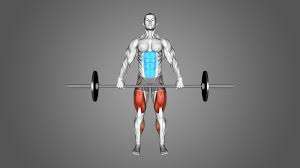Ah, the deadlift—a gym classic that is as loved as it is feared.
Ask any seasoned lifter, and they will likely have stories of personal triumphs or epic fails with this lift.
But beyond the tales of victory (or backaches), deadlifts are actually an incredible full-body workout, with a special focus on building core strength. And when done correctly, they’re a one-way ticket to achieving a lean, chiseled physique.
Today, leanandfit.info will dig into why this compound exercise deserves a permanent spot in your workout routine.
Article Index:
- Why Deadlifts Are More Than Just a Leg Exercise
- How Deadlifts Activate Your Core Muscles
- The Science Behind Core Engagement During Deadlifts
- Real-Life Example: Jane’s Journey to Core Strength
- Deadlifts vs. Crunches: The Core Strength Debate
- How Deadlifts Contribute to a Leaner Physique
- The Role of Stability in Core Strength Development
- FAQs on Deadlifts fir Core Strength Development
- Common Mistakes That Undermine Core Activation
- Scientific Evidence Supporting Deadlifts for Core Strength
Why Deadlifts Are More Than Just a Leg Exercise?
Most people think deadlifts are all about bulking up your legs and lower back.
Spoiler alert: they are wrong.
While deadlifts do a stellar job of working your glutes and hamstrings, they are also one of the best exercises for your core.
Essentially, deadlifts engage nearly every muscle in your body leading to muscle hypertrophy, but your core muscles work overtime to stabilize your spine and keep your form intact.
According to Strength and Conditioning Journal, deadlifts are an “all-hands-on-deck” exercise that engages the abdominals, obliques, and even those deep stabilizing muscles you did not know existed.
This full-body activation not only helps build strength but also contributes to calorie burning—more on that later.

How Deadlifts Activate Your Core Muscles?
Deadlifts are more than just a lower-body power move—they are one of the most effective exercises for building true core strength.
Every time you pull that barbell off the ground, your core muscles are working behind the scenes to keep your spine stable and your body upright.
Let’s explore exactly how this happens step by step.
It all Starts with the Setup:
Before lifting the weight, you take a deep breath and brace your core tightly. This is not just about sucking in your stomach—it is about creating intra-abdominal pressure that turns your torso into a solid, unyielding pillar. Think of it like inflating a balloon in your belly; this pressure keeps your spine from folding forward when you begin the lift.
The Initial Pull Engages your Spinal Stabilizers:
As you drive through your heels and lift the bar, your abs, obliques, and deep muscles like the transverse abdominis contract to prevent the torso from collapsing. At the same time, your lower back muscles—particularly the erector spinae—activate to keep the spine neutral and upright.
As the Bar Passes your Knees, the Entire Core Fires:
Your glutes and hamstrings do the heavy lifting, but your core remains fully braced. This integrated tension is what keeps you from rounding your back or tipping forward. Even without doing planks for core development, you are training your core to work in real-life, functional ways.
At the Top of the Lift, a Final Squeeze:
As you lock out the lift, your abs and glutes work together to align your hips and keep your ribcage from flaring. This full-body tension is crucial for spinal health.
Lowering the Bar is No Break:
As you hinge back down, your core stays tight to control the descent. Letting it go soft now can lead to poor posture or even injury.
Example: Try a single-leg deadlift and you’ll immediately feel how much core control is needed just to stay upright. It’s a brilliant demonstration of how deadlifts challenge your balance, strength, and coordination—all centered around your core.
The Science Behind Core Engagement During Deadlifts
Deadlifts are often hailed as the king of strength training exercises, and for a good reason.
They compel your body to engage multiple muscle groups all at once, making them one of the most effective full-body workouts.
But what really sets deadlifts apart from other exercises is the vital role your core plays throughout the entire movement.
Your core essentially acts as the stabilizing powerhouse, bracing your spine and efficiently transferring force between your upper and lower body.
When you lift a heavy barbell off the ground, your core muscles tighten and work synergistically to maintain spinal alignment.
This bracing action prevents your back from rounding or your hips from wobbling, ensuring a safe and effective lift.
The importance of core stabilization during deadlifts isn’t just bro science thrown around in weightlifting circles—there is actual data to back it up.
A study published in the Journal of Strength and Conditioning Research highlights that deadlifts significantly activate both the rectus abdominis (your “six-pack” muscles) and the erector spinae (the muscles running along your spine).
This level of engagement is far greater than what you would achieve with traditional core exercises like crunches or leg raises.
Why?
Because deadlifts force your core to act as a stabilizing unit rather than isolating specific muscles, providing functional strength (such as building lean leg muscles by hiking) that not only enhances performance in other lifts but also supports everyday movements like bending, lifting, and even maintaining good posture.
Additionally, strengthening the core with deadlifts can contribute to a leaner physique.
Engaging multiple large muscle groups requires a considerable amount of energy, leading to a higher calorie burn.
Over time, this increased metabolic demand helps reduce body fat, making those core muscles you’re building even more visible.
It is a comprehensive approach to core strength and overall fitness, with benefits extending far beyond aesthetics.
Jane’s Journey to Core Strength
Meet Jane, a 35-year-old office worker who suffered from chronic lower back pain and weak core muscles.
Traditional ab exercises weren’t cutting it, so her trainer introduced her to deadlifts.
After three months of consistent lifting, Jane noticed a remarkable improvement. Not only did her back pain subside, but she also developed a leaner midsection.
“I went from feeling weak and unstable to having a rock-solid core. And the best part? I didn’t have to spend hours doing boring crunches.”
Deadlifts vs. Crunches: The Core Strength Debate
Let’s settle this age-old debate once and for all.
Sure, crunches and sit-ups give you that satisfying abdominal burn, but when it comes to functional core strength, they simply cannot hold a candle to deadlifts.
While crunches are great for working the rectus abdominis—the muscles responsible for that classic six-pack—deadlifts engage a much broader range of core muscles.
And here’s the key: they make your core not just look good but actually perform well in real-life situations.
Deadlifts force your core to act as a stabilizing powerhouse.
They require bracing your abs, obliques, and lower back muscles to keep your spine safe and aligned while lifting heavy weights.
This is what sports scientists and strength coaches refer to as “functional core strength”—the type of strength training that translates to better performance in daily activities, like carrying heavy groceries, lifting boxes, or even maintaining good posture.
In contrast, crunches mostly target the front of your abs, offering little to no benefit for the stabilizing muscles that are crucial for real-world movements.
Dr. Mark Johnson, a respected sports scientist, explains it well: “Deadlifts provide a superior core workout because they mimic real-life movements that require total body stability.
Crunches do not translate well to everyday activities.”
Essentially, if your goal is to develop a core that is both strong and functional—one that improves your overall fitness and helps prevent injuries—deadlifts should be your top pick.
Plus, the calorie burn from performing deadlifts can even contribute to a leaner physique over time.
>>> Want to Check Out My “Secret Fat Loss Recipe” that has Helped Me “Lose Visceral Body Fat” at Warp Speed??? Click Here to Find Out! <<<
FAQs on Deadlifts for Core Strength Development
How Deadlifts Contribute to a Leaner Physique?
Okay, so deadlifts build core strength—but how do they help you get lean?
Here is where you need to pay attention.
Deadlifts are a compound movement, meaning they burn a ton of calories by engaging multiple muscle groups.
More muscle engagement equals more calorie burn, which is essential for shedding fat and revealing a lean physique.
Moreover, muscle is metabolically active tissue.
The more muscle you build (thanks to deadlifts), the higher your resting metabolic rate becomes.
This means you burn more calories even when you are binge-watching your favorite series.
It is a win-win situation.
The Role of Stability in Core Strength Development
When you perform a deadlift, your core muscles work hard to keep you stable.
This is where the magic happens.
The act of lifting a heavy weight without collapsing requires intense core activation, which translates to better overall stability and balance.
Professional athletes often incorporate deadlifts into their training for this very reason.
Stability is not just for gym enthusiasts; it is crucial for anyone who wants to move efficiently and avoid injuries.
Common Mistakes That Undermine Core Activation
Even the best exercise can be rendered useless if done incorrectly.
One common mistake is rounding the lower back during deadlifts, which not only diminishes core activation but also increases the risk of injury. Another faux pas?
Using momentum instead of controlled movement.
To get the most out of your deadlifts, focus on maintaining a neutral spine and engaging your core throughout the lift.
The Journal of Sports Science emphasizes the importance of proper form, noting that poor technique can negate the exercise’s benefits.

Scientific Evidence Supporting Deadlifts for Core Strength
Still skeptical?
Let’s look at more data.
A study from The Journal of Applied Physiology found that heavy lifting exercises like deadlifts or resistance band squats lead to significant improvements in core strength and muscular endurance.
The study highlighted that participants who included deadlifts in their training routines had a stronger core and better posture compared to those who did traditional core exercises.
Another research article in Sports Medicine corroborates these findings, stating that deadlifts are one of the most effective exercises for engaging the posterior chain, including the core muscles.
Takeaway: Understanding the Power of Deadlifts
Deadlifts may seem intimidating, but their benefits are undeniable.
From building a stable, strong core to helping you achieve a leaner physique, this exercise does it all.
While we would not dive into solutions or tips here, understanding how deadlifts work can inspire you to include them in your workout routine.
Just remember to lift with proper form and start with manageable weights to avoid injuries.
References: